Osteospermum scariosum
Osteospermum scariosum DC.
Family: Asteraceae
Common names: sheep bush, sheep boneseed (Eng.); skaapbos, bietou, sagtebietou (Afr.)
Introduction
Osteospermum scariosum is a beautiful yellow daisy, the flowerheads often having a striking dark ring around the centre.

Description
Description
A perennial herb or dwarf shrub to 300 mm, with a woody rootstock that has one to several erect or ascending annual stems. The whole plant can be hairy. The lower leaves are the largest, being broad and rectangular, or lanceolate with a tapering base, and with a rounded apex. The sides are of unequal lengths, and the margins are minutely to coarsely sinuate or toothed, or rarely deeply incised, the teeth having cellulose tips. The upper leaves are usually narrower, decreasing in size towards the top of the plant, linear-lanceolate to oblong, not stalked, often with little ear-like lobes at the base, and rounded or pointed at the tip. The margins of these upper leaves are similar to the lower leaves, toothed only at the tip, or sometimes smooth and lacking teeth.
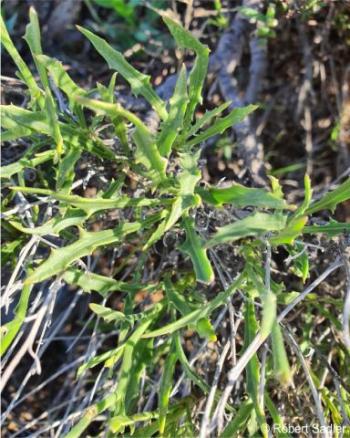
The flowering stem can be branched or unbranched, bearing one to several flowerheads. Each flowerhead is surrounded by a ring of green involucral bracts with dry, translucent margins and are approximately 12-15 mm long. The ray flowers are large, double the length of the involucral bracts, and all the flowers are yellow, although the ray flowers often have a dark violet or black-brown base, which produces a dark ring around the centre of the floral display, known as the eye. Only the outer, or ray flowers produce fruit. The fruits are striking, being 9-12 mm long and comprising a central spindle-shaped fruit body with three broad, translucent, often purple-tinged wings. At the top of the central fruit body, between each pair of wings, there is a thin membrane, the fenestrum or ‘window’, over an air cavity.
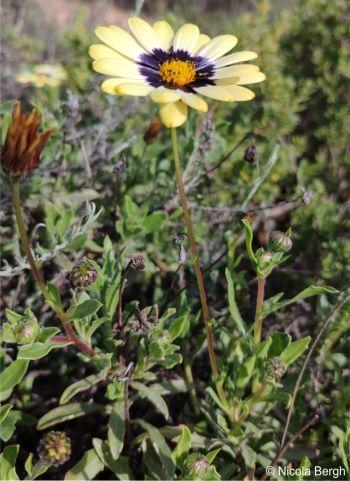
Conservation Status
Status
This species is Red Listed as Least Concern (LC) because it is widespread and not threatened.
Distribution and habitat
Distribution description
This species occurs naturally over a large geographic area, which inlcludes Namibia, Botswana, Lesotho, and large parts of South Africa where it has been recorded in eight provinces, Northern Cape, Western Cape, Eastern Cape, Free State, Northwest, Gauteng, Mpumalanga and Limpopo. Osteospermum scariosum occupies a large range of rainfall regimes, summer-arid, winter-arid, all-year, mesic, and semi-arid, on various soil types, it occurs mostly on shale soils derived from a range of bedrock types, but also calcretes in the Stilbaai area and in many biomes, Succulent Karoo, Fynbos, Nama Karoo, Savanna as well as the Grassland Biome.
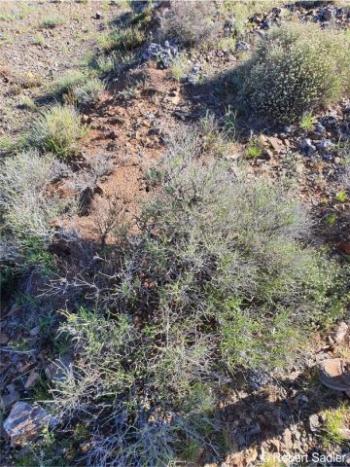
Derivation of name and historical aspects
History
The genus name Osteospermum is derived from the ancient Greek words osteon, meaning ‘bone’ and sperma, meaning ‘seed’, referring to the very hard seed inside the fruit. Osteospermum is a large genus of around 90 species of mainly yellow-flowered annual and perennial daisies distributed in the Mediterranean, throughout temperate Africa, and in southern Africa, but with most of its diversity in the Greater Cape Floristic Region of South Africa (Manning & Goldblatt 2012). While the tribe Calenduleae, to which Osteospermum belongs, is characterised by the lack of a pappus, dispersal instead being aided by outgrowths on the fruit (Nordenstam Kallersjo 2009), the genus Osteospermum is distinguished from other genera in Calenduleae largely by the fact that the central disc florets are functionally male and do not produce fruit. The widely utilised Eurasian genus Calendula L., now Osteospermum section Calendula (Manning & Goldblatt 2012) is nested within Osteospermum (Nordenstam & Kallersjo 2009; Sadler et al. 2022).
The specific epithet scariosum refers to the margins of the involucral bracts and is derived from the botanical Latin scariosus meaning ‘scarious’ or ‘of thin, dry membranous texture and not green’, the opposite of herbaceous (Magill 1990).
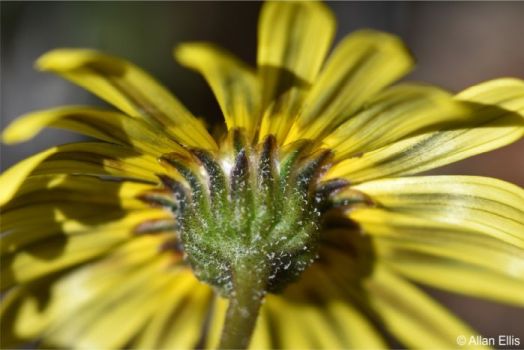
In 1838, the Swiss botanist De Candolle, working in Geneva, described two species in the same publication: Osteospermum scariosum, based on a collection by Ecklon & Zeyher from “Graafreynet”, and Tripteris aghillana, based on a collection by Drége from “Cap. Aghillas”. The genus name Tripteris is derived from the Greek and Latin tri, meaning ‘three’, and the Greek pteron, meaning ‘wing’, referring to the three-winged fruits. In 1943, the Swedish botanist Tycho Norlindh, merged Tripteris into Osteospermum, creating subgenus Tripteris for species with three-winged fruits, and he reaslised that Tripteris aghillana and Osteospermum scariosum were the same species (Norlindh 1943). In 2006, another Swedish botanist, Bertil Nordenstam, resurrected the genus Tripteris, and so Osteospermum scariosum again became Tripteris aghillana, the oldest available name (Nordenstam 2006). Osteospermum scariosum remained a synonym of T. aghillana. In 2012, during the phylogenetic and DNA sequencing era, new data demonstrated that Tripteris species were scattered inside the Osteospermum lineage. As a result, Tripteris aghillana was again changed to Osteospermum scariosum (Manning & Goldblatt 2012).
Ecology
Ecology
This plant exhibits drought resistance and can thrive in challenging climates, even within arid regions of the Karoo and Kalahari. This resilience is evident in the stunted specimens found in the dry Karoo areas, in contrast to the more luxuriant growth observed along riverbanks and streams. The plant can adapt to a wide range of soils and habitats, including dry sandy terrain, rocky outcrops, well-drained loamy-clay soil, sandy loam, shale with some dolerite ridges, limestone, Table Mountain Sandstone plateau, Ecca shale with dolerite, basaltic loam, black turf, outcrops, and is recorded growing naturally on hills, mountain slopes, and disturbed areas in grasslands, savannas, semi deserts, and succulent karoo environments. Its altitude range spans from 100 to 1 900 m above sea level. The main flowering period is in spring and summer and typically extends from September to March. The fruit is dispersed by wind.
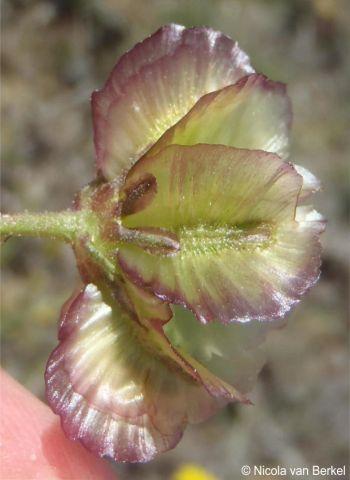
Uses
Use
There are no current recorded medicinal uses of the plant, but Van Breda & Barnard and Le Roux et al. describe Osteospermum scariosum as very palatable and good for livestock grazing.
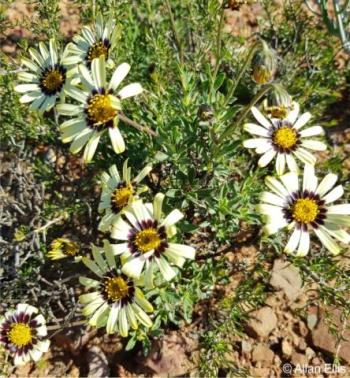
Growing Osteospermum scariosum
Grow
Cultivation of this plant is easy. Sow seeds in autumn, cover with a thin layer of soil and keep the soil most. The seeds require light to germinate rapidly. Seedlings will germinate in about 2 weeks. Water the seedlings from the base and avoid wetting the leaves to prevent fungal diseases. The plant thrives in full sun, and prefers well-drained, evenly moist soil. Too-wet soil over stresses or kills the plant. Once grown the plant is drought tolerant. Addition of a balanced fertilizer on the soil in spring before planting, as well as a liquid fertilizer in summer will assist the plant with blooming. Pesticides may be required to keep away thrips, which are the most common pests found on the plant. These insects feed on the pollen and scrape the petals with their sharp mouthparts, ruining the floral display.
Propagation is a popular practice with Osteospermum and the closely related genus Dimorphotheca in general and is usually done by means of cuttings; these are taken from non-flowering shoots, about 7.5-12.5 cm long. The leaves from the bottom part of the cutting are removed, the naked end it is then dipped in a rooting hormone, and it is placed in well-drained soil.
References
- Better Homes and Gardens. How to grow and care for Osteospermum. https://www.bhg.com/gardening/plant-dictionary/annual/osteospermum/. Accessed on 2023/09/20.
- Herman, P.P.J., Swelankomo, N. & Condy, G. 2011. Tripteris aghillana var. aghillana. Flowering Plants of Africa 62:140–146.
- Le Roux, P.M., Kotze, C.D., Nel, G.P & Glen, H.F. 1994. Bossieveld. Grazing plants of the Karoo and karoo-like areas. Bulletin 428. Department of Agriculture, Pretoria.
- Magill, R.E. 1990. Glossarium polyglottum bryologiae. A multilingual glossary for bryology. Monographs in Systematic Botany from the Missouri Botanical Garden 33:1-297.
- Manning, J. & Goldblatt, P. 2012. Plants of the Greater Cape Floristic Region 1: the Core Cape Flora. Strelitzia 29. South African National Biodiversity Institute, Pretoria.
- Nordenstam, B. & Källersjö, M. 2009. Calendulae. Chapter 35:527-537 in: Funk, V.A., Susanna, A. Stuessy, T.F. & Bayer, R.J. (eds). Systematics, evolution, and biogeography of Compositae. International Association for Plant Taxonomy, University of Vienna.
- Nordenstam, B. 2006. Generic revisions in the tribe Calenduleae (Compositae). Compositae Newsletter 44: 38-49.
- Norlindh, T. 1943. Studies in the Calenduleae I: Monograph of the genera Dimorphotheca, Castalis, Osteospermum, Gibbaria and Chrysanthemoides. C.W.K. Gleerup, Lund.
- Nu-leaf Nursery. Osteospermum. https://www.nuleaf.co.za/shop/summer-perennials/osteospermum/. Accessed on 2023/09/20.
- Sadler, R. 2019. Whoopsie Daisy: revisiting the taxonomy of Calenduleae on a novel phylogeny. BSc(Hons) dissertation, University of Cape Town.
- Sadler, R. et al. 2022. A molecular phylogeny of Calenduleae (Asteraceae) supports the transfer of Dimorphotheca polyptera DC. to Osteospermum L. South African Journal of Botany 151(2): 234-245.
- Van Breda, P.A.B. & Barnard, S.A. 1991. 100 Veld plants of the winter-rainfall region: a guide to the use of veld plants for grazing. Bulletin no. 422. Dept. of Agriculture Development, Cape & Transvaal Printers for the Government Printer, Pretoria.
- Van der Colff, D. & Von Staden, L. 2020. Osteospermum scariosum DC. National Assessment: Red List of South African Plants version 2020.1. Accessed on 2023/09/20.
Credits
Khanya Ntondini & Nicola Bergh
Compton Herbarium, Foundational Biodiversity Science
November 2023
Acknowledgements: the authors thank Robert Sadler, Allan Ellis and Nicola van Berkel for providing some of the images used.
Plant Attributes:
Plant Type: Perennial
SA Distribution: Eastern Cape, Free State, Gauteng, Limpopo, Mpumalanga, North West, Northern Cape, Western Cape
Soil type: Sandy, Loam
Flowering season: Spring, Early Summer, Late Summer
PH:
Flower colour: Black, Yellow
Aspect: Full Sun
Gardening skill: Easy
Special Features:
Horticultural zones











Rate this article
Article well written and informative
Rate this plant
Is this an interesting plant?
Login to add your Comment
Back to topNot registered yet? Click here to register.